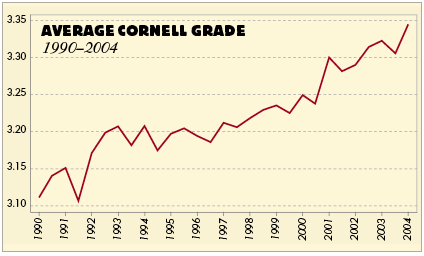Grade Inflation at Cornell
Gut Check – Grade Inflation at Cornell (Atlantic Monthly)

In 1997 Cornell University began posting median grades for every course online, so that students could put their own grades in a larger perspective. (After all, an A in “Physics for Poets” is presumably less impressive than an A in “Physics for Physicists.”) The university’s theory—which reveals an astonishing naiveté about human nature—was that this would encourage students to choose more-challenging courses. Instead, according to a paper published early this year by two Cornell economists, the policy provided a case study in how to pump up GPAs. Armed with accurate, official grading information, students used it to pick easy classes and avoid difficult ones: once-hidden guts were now readily identified, enrollment in them ballooned, and since the new policy was instituted the overall rate of grade inflation—already a subject of concern at Cornell, as in the academic world in general—has more than doubled.
—“Quest for Knowledge and Pursuit of Grades: Grade Information and Inflation at an Ivy League School,” Talia Bar and Asaf Zussman, Cornell University
Of course, other factors could explain some of this inflation. Still, an amusing case study in student psychology. Even smart students–perhaps especially smart students–are more concerned with doing what’s necessary to get good grades than with learning per se. It’s up to professors to make the two match up as well as possible.






Do they use purple ink instead of red, too?